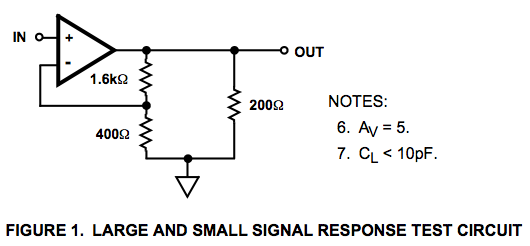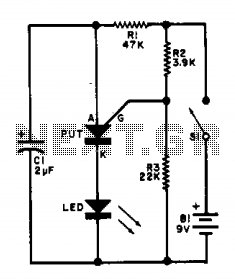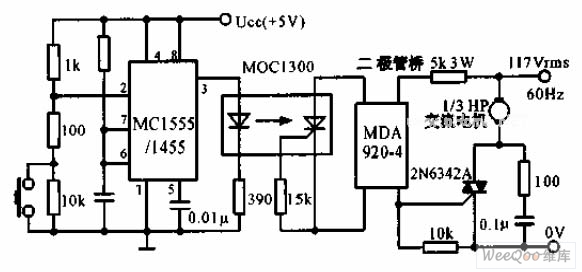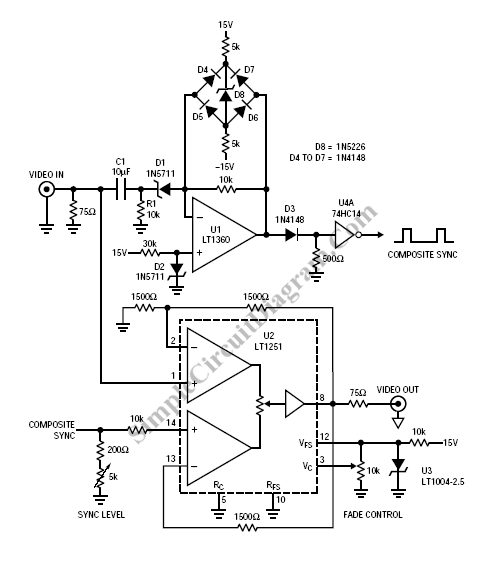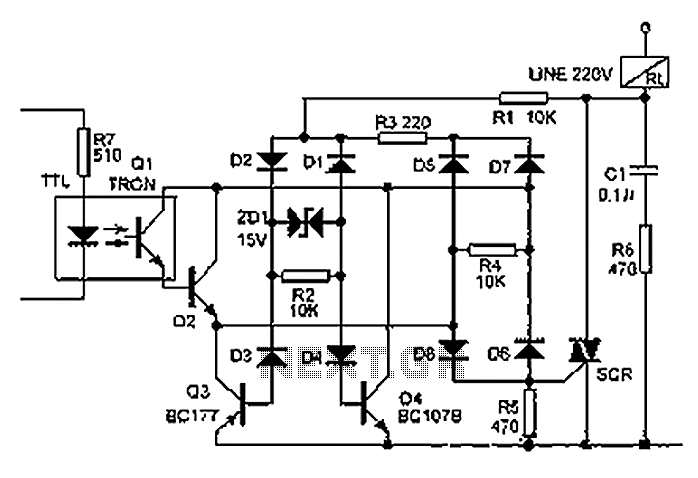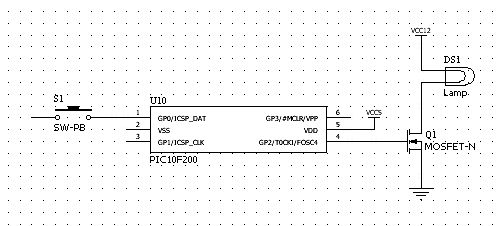
mains ac xenon tube flasher circuit
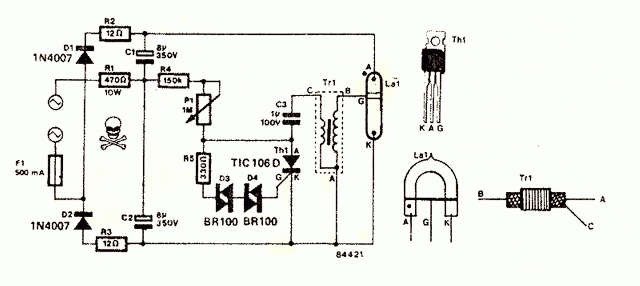
The circuit was taken from an old Elektor electronics magazine and is a compact design suitable for generating high-intensity lighting effects during festivals, parties, and gatherings. Diodes D1 and D2, along with capacitors C1 and C2, form a voltage doubler circuit that produces a voltage level twice that of the input voltage across C1 and C2. The circuit features a tube filled with inert xenon gas. A metal ring is attached to the anode side of the tube, which serves as the gate trigger point for the device. This ring is terminated with a wire for connection to a pulse source. When a high voltage is applied across the anode and cathode pins of the tube, and a pulse is applied to the trigger gate wire and cathode, the tube charges up and allows the full voltage across its anode and cathode to pass through, creating an intense arc of light inside the tube due to the flow of high-speed electrons through the xenon gas.
The described circuit utilizes a voltage doubler configuration, which is an effective method for increasing the voltage from a low-voltage AC source. The diodes D1 and D2 are arranged in such a way that they rectify the AC input, while capacitors C1 and C2 store and double the voltage, ensuring that the circuit can produce a sufficient voltage to trigger the xenon gas tube.
The xenon gas tube operates based on the principle of gas discharge. When the voltage across the anode and cathode reaches a certain threshold, the inert gas ionizes, allowing current to flow through the tube. The metal ring serves as a trigger point; when a pulse is applied, it initiates the discharge process. The resulting arc creates a bright flash of light, which is ideal for visual effects in various events.
To ensure proper functionality, the circuit should be designed with appropriate values for the diodes and capacitors to handle the expected input voltage and current. The choice of diodes should consider their reverse voltage ratings and forward current capacities. Capacitor values must be selected to provide adequate energy storage while considering the ripple voltage and discharge characteristics.
Safety precautions are critical when working with high voltages, especially in circuits involving gas discharge tubes. Proper insulation and protective components should be utilized to prevent accidental contact with live parts. Additionally, the circuit should be housed in a suitable enclosure to protect users from electric shock and to contain any potential hazards associated with the operation of the xenon tube.
In summary, this circuit design is a practical solution for generating high-intensity lighting effects, leveraging a voltage doubler configuration and the unique properties of a xenon gas tube. Proper component selection and safety measures are essential for reliable and safe operation.The circuit was taken from one of the old elektor electronics magazine and it is indeed a very cute little circuit which may be used for creating high intensity lighting effects during festivals, parties and fun gatherings. Diodes D1 and D2 along with the capacitors C1 and C2 form a voltage doubler circuit which creates a voltage level twice the v
alue of the input voltage (across C1/C2). As the name suggests, its a tube filled with inert xenon gas. A metal ring is attached toward the anode side of the tube which becomes the gate trigger point of the device. Thisring isterminatedwith a wire so that it can be connected with s pulse source. When a high voltage is set across the anode/cathode pins of the tube and a pulse applied across the trigger gate wire and cathode, the tube gets charged up and allows the whole voltage across its Anode.
cathode to pass through creating an intense arc lighting inside the tube due to thepassageof the high speed electrons through the xenon gas. 🔗 External reference
The described circuit utilizes a voltage doubler configuration, which is an effective method for increasing the voltage from a low-voltage AC source. The diodes D1 and D2 are arranged in such a way that they rectify the AC input, while capacitors C1 and C2 store and double the voltage, ensuring that the circuit can produce a sufficient voltage to trigger the xenon gas tube.
The xenon gas tube operates based on the principle of gas discharge. When the voltage across the anode and cathode reaches a certain threshold, the inert gas ionizes, allowing current to flow through the tube. The metal ring serves as a trigger point; when a pulse is applied, it initiates the discharge process. The resulting arc creates a bright flash of light, which is ideal for visual effects in various events.
To ensure proper functionality, the circuit should be designed with appropriate values for the diodes and capacitors to handle the expected input voltage and current. The choice of diodes should consider their reverse voltage ratings and forward current capacities. Capacitor values must be selected to provide adequate energy storage while considering the ripple voltage and discharge characteristics.
Safety precautions are critical when working with high voltages, especially in circuits involving gas discharge tubes. Proper insulation and protective components should be utilized to prevent accidental contact with live parts. Additionally, the circuit should be housed in a suitable enclosure to protect users from electric shock and to contain any potential hazards associated with the operation of the xenon tube.
In summary, this circuit design is a practical solution for generating high-intensity lighting effects, leveraging a voltage doubler configuration and the unique properties of a xenon gas tube. Proper component selection and safety measures are essential for reliable and safe operation.The circuit was taken from one of the old elektor electronics magazine and it is indeed a very cute little circuit which may be used for creating high intensity lighting effects during festivals, parties and fun gatherings. Diodes D1 and D2 along with the capacitors C1 and C2 form a voltage doubler circuit which creates a voltage level twice the v
alue of the input voltage (across C1/C2). As the name suggests, its a tube filled with inert xenon gas. A metal ring is attached toward the anode side of the tube which becomes the gate trigger point of the device. Thisring isterminatedwith a wire so that it can be connected with s pulse source. When a high voltage is set across the anode/cathode pins of the tube and a pulse applied across the trigger gate wire and cathode, the tube gets charged up and allows the whole voltage across its Anode.
cathode to pass through creating an intense arc lighting inside the tube due to thepassageof the high speed electrons through the xenon gas. 🔗 External reference
